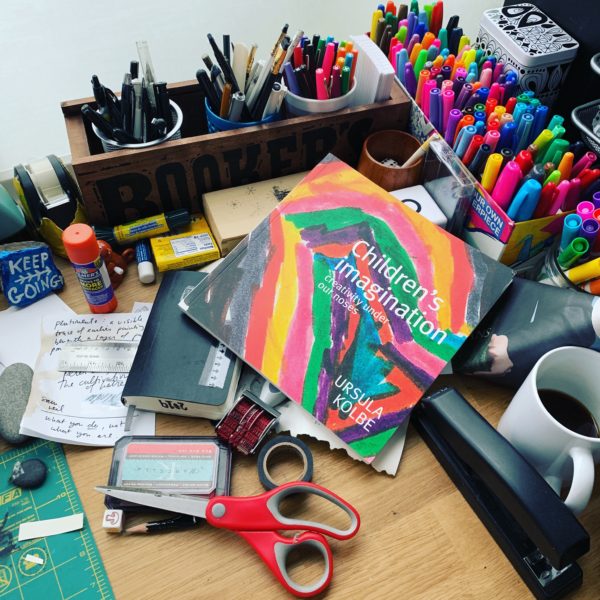
Artists and children both need the right combination of time, space, and materials to do their work.
Here’s how Ursula Kolbe puts it in her book Children’s Imagination: Creativity Under Our Noses (emphasis mine):
The elements of time, space and materials make it possible for children to explore, invent and make their ideas visible. Thinking of these elements as invitations gets to the heart of the matter.
It’s the combination of unhurried and uninterrupted time, inviting spaces and materials that guides mind and hands, that invites creative thinking. Seeing, handling, and thinking are inseparable, as Rudolf Arheim, psychologist and scholar of art and ideas, reminds us.
Together, time, space and materials provide ‘invitations to act’.
Those adjectives are extremely important: unhurried and uninterrupted time, and inviting spaces and materials.
Years ago, my friend John T. Unger turned “time, space, and materials” into an equation for producing work. (Only he uses the word resources instead of “materials” — “Resources meaning materials and tools, or the money to get them.”)
Time + Space + Resources = Work
His insight was that you need all three at the same time, otherwise you fall into idleness. Here, in John’s words, are variations on the equation:
T+R-S=Idle: You have time and resources but no work space. Examples: a rock band with close neighbors, a dancer with a no floor space, any visual artist whose space is improperly ventilated, too small, or is not conducive to the use of their proper tools.
T+S-R=Idle: You have time and space but no resources. Example: you quit your job and moved into your parent’s basement, but ran out of paint & canvas. Or you saved up enough cash to rent a big space and take time off, but your welder just blew out it’s coil and there’s not enough cash left to fix it. Or you took a part time job so you’d have
more time to work, but you can’t afford materials after you pay the rent.R+S-T=Idle: You have resources and space, but all your time is used to maintain them. Example: You have a great job that pays for a huge loft and you’ve purchased everything you need to do a big project. But every night when you come home, you’re just too burned out to get anywhere with the stuff.
“The trouble is,” he says, “it’s almost impossible to get all three at once.”
Time gets used to make money. Money gets used to pay for space. Space is hard to justify unless you have the time and resources to make it pay for itself. The whole equation can easily turn into a vicious circle in which you constantly have to rob Peter to pay Paul.
We can easily see this play out in the lives of children, too.
For example:
S + M – T = You provide a nice space and plenty of materials in the classroom, but the bell rings and it’s time to stop for the day, regardless of where the children are in their work.
T + S – M = You provide the time and space for children to work, but all you’ve given them to draw with is crummy old crayons and scrap paper.
M + T – S = You provide great materials and lots of time, but nowhere to spread out.
Etc.
My question is whether increasing the quality or amount of a variable in the equation can make up for a lack of one the others.
So, for example, you have very little time, but you have a dedicated space and materials ready to go so you can pop in at any opportune moment and work.
Or, you have no space to work, but you get up early when the kids are in bed, and use the kitchen table.
I’m scratching my head thinking about how space and time can make up for a lack of materials, which might reveal something about their importance. I suppose if you have lots of time, you can scrounge around for materials?
I’ll think about it some more, but until then, remember the equation:
Time + Space + Materials = Work